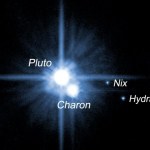Horizons
On the USA Science and Engineering Festival blog, astronaut John Grunsfeld describes what it's like to rocket into space. Astronauts first spend two hours strapped in on the launchpad, "flipping switches and thinking about our training and the jobs we have to do." They count down to ignition, mindful of the 4.5 million pounds of explosive in the fuel tanks. After liftoff, the shuttle accelerates out of Earth's atmosphere in less than nine minutes, causing each astronaut to feel like they weigh 700 pounds. An instant later, they are weightless. On Starts With a Bang, Ethan Siegel shares…
Dear Readers,
It is our great pleasure to bring you news of an exciting new partnership, starting today, between ScienceBlogs and National Geographic.
ScienceBlogs and National Geographic have at their cores the same ultimate mission: to cultivate widespread interest in science and the natural world. Starting today, we will work together to advance this common mission through new content, applications, and initiatives. We will bring acclaimed voices from National Geographic into our rich discussion on ScienceBlogs, and National Geographic will invite their worldwide audience to join the…
Sure, astronomers might not call it a planet anymore, but every schoolchild knows how badass Pluto really is. It's got a giant moon, Charon, and two smaller ones, Hydra and Nix.
In addition to being colder than ice with an average temperature of 44 Kelvin (that's colder than liquid nitrogen), I'm here to bring you the news that despite the fact that it's so cold and so far from the Sun, Pluto has been melting!
Since its discovery by Clyde Tombaugh in 1930, astronomers have been fascinated with Pluto, making very careful observations of it, trying to learn more about this bizarre, icy sphere…

